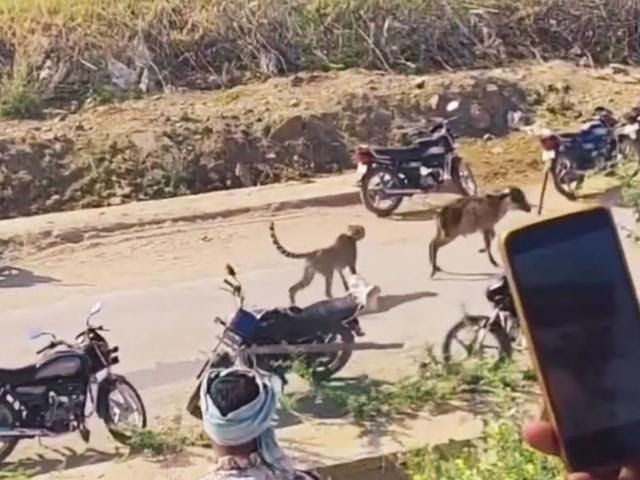Villagers shot videos and took pictures with their mobile phones as a coalition of cheetahs attempted to kill a calf on the outskirts of a village located at the edge of Kuno National Park. As the cheetahs pounced on the calf, the villagers yelled and pelted stones at the cheetahs as they ran into the forest. Although the cheetah trackers tried to stop the villagers, they were outnumbered. This incident has raised serious questions, especially at a time when the project is considered to be on the right track after the release of 17 cheetahs into the wild. Critics have once again asked: Are the animals safe? Will Kuno’s villages face more cases of human-animal conflict? And the biggest question: Can Kuno support 17 cheetahs and provide enough prey to sustain them? Let’s analyze this with the help of Grok, a generative artificial intelligence chatbot developed by xAI.
Stones Hurled At Cheetahs
But first, the real-life drama on the dusty tracks of Sheopur, where Kuno is located. Inside any national park, this would have been a dream moment for any wildlife tourist and worth their money, as Jwala and her four cubs chased a cattle calf in Beharda village on March 24. The village is located on the edge of Kuno forest. The cheetahs swoop upon the cattle. But stones hurled by villagers did not allow them to kill the calf. A large number of villagers were already gathered when they spotted the cheetahs coming out from a farm field. As they crossed the clay road, one of the cheetahs confronted a calf. There were number of bikes parked on both sides of the untarred rural road. The cheetah waded its way and reached near the cattle. The villagers rolled their mobile camera and start shooting every moment. The calf ran for life and cheetahs chased it and almost killed the animal when a villager picked up a stone and threw at the cheetahs “to save the calf”, an official said. In fact there were two villages who threw stones.
The cheetah tracking team stopped them. Cheetahs soon vanished into the woods leaving many questions for the Kuno managers. Were cheetahs hungry and looking for a kill? Is there enough prey inside the forest where cheetahs have to compete with leopards? A former senior official the Wildlife Institute of India termed it a “total mess”. “Imagine if the stones that scared the cheetahs had hit them in the face”, asked an official as scared as cheetahs. This has also given confidence to the villagers that they can scare cheetahs by doing so. A senior wildlife official was quick to respond, “the villagers are compensated adequately for their cattle lose. And they must also understand ( the rural folk) that attacking cheetah and hurting them amounts to a serious crime”.
This has also initiated the debate of the capacity of the 748 sq km park vis a vis the presence of 17 cheetahs. I asked Grok to analyze it. It said- Kuno National Park is sufficient for 17 cheetahs depends on several factors, including prey availability, habitat size, and the presence of competing predators. Let’s break it down based on available information and ecological considerations. Kuno National Park spans approximately 748 square kilometers, with a larger surrounding landscape of over 3,000 square kilometers that could potentially support cheetahs. The original Cheetah Action Plan, the Grok said, developed by the Wildlife Institute, estimated that Kuno could sustain up to 21 cheetahs based on prey availability, primarily cheetal (spotted deer), alongside other species like chinkara and nilgai. This suggests that, in theory, the park could support 17 cheetahs, as it’s below the estimated carrying capacity of 21.
Prey Supplementation or Habitat Expansion Required
However, real-world conditions complicate this picture, the Grok added. As of March 2025, Kuno has 26 cheetahs—12 adults and 14 cubs—with 17 currently roaming free in the wild and 9 in enclosures. The AI tool said , the park has faced challenges since the cheetah reintroduction began in 2022. Reports indicated a significant decline in the cheetal population, with an estimated 25% loss (around 2,250 individuals) within a year of the project’s start, dropping to about 6,500 cheetal. This reduction is largely attributed to over 90 Kuno leopards, which compete with cheetahs for prey. Cheetahs, being less dominant than leopards, may struggle to access sufficient food, especially in a landscape where prey density has fallen to around 18 cheetal per square kilometer—enough for perhaps 15 cheetahs at most, according to some experts like Dr. Y.V. Jhala, a key figure in the project.
Also read: Selfie With Leopard
Space is another concern. Cheetahs require large territories, especially males, who can claim areas of 100 square kilometers or more in the wild. In unfenced reserves like Kuno, studies from Africa suggest a density of less than 1 cheetah per 100 square kilometers is typical. For 17 cheetahs, this implies a need for at least 1,700 square kilometers of suitable habitat. While the broader Kuno landscape exceeds this, the core park (748 sq km) alone might not suffice if all 17 were confined there, particularly with leopards and potential human-wildlife conflict in the surrounding 169 villages. The project has also faced ecological critiques. Namibian researchers argued that Kuno’s carrying capacity was overestimated, ignoring cheetahs’ spatial needs, and that the park might only sustainably host a handful of males (3-5) without them dispersing beyond its boundaries. The prolonged captivity of most cheetahs—over a year in enclosures due to health issues like septicaemia in 2023—further suggests adaptation challenges, potentially reducing their ability to thrive in the wild, the Grok feels.
On the flip side, recent releases (e.g., 5 cheetahs in February 2025 and 5 more, including Gamini and her cubs, in March 2025) indicate some success, with cheetahs hunting cheetal and surviving alongside leopards. In conclusion, according to the Grok, Kuno National Park can likely support 17 cheetahs in the short term, given current numbers and phased releases, but it may not be sufficient for a long-term, free-ranging population without significant prey supplementation or habitat expansion. The prey base and leopard competition remain critical bottlenecks, and the park’s capacity could be stretched thin as cubs mature and demand more resources. Ongoing monitoring and management will be the key to determining if 17 cheetahs can thrive there sustainably.
By: Deshdeep Saxena
Image courtesy :Video grabs from the videos shot by villagers



.jpeg)
.jpeg)